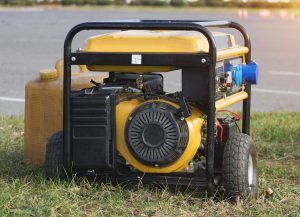Print a Sign-In Sheet | Spanish Version Coming Soon
The use of portable generators is common after natural disasters, such as tornadoes, hurricanes, storms, and flooding. They are also used on a lot of jobsites where there is no access to electricity. Portable generators are only meant to be used on a temporary basis.
A generator produces electricity and if not grounded properly can cause serious injury. The major risk of injury is from shocks and electrocution. Proper grounding protects the employee by providing an alternate path for electricity to flow to the ground (earth) in the event of a fault in the electrical wiring system.
Tips to prevent injury:
- Conduct a pre-use safety check of the generator.
- Follow all manufacturer’s safety recommendations.
- Ensure generators have an open transition transfer switch if placing it directly on the electrical system of a structure.
- Avoid using extension cords.
- Plug electrical appliances and tools directly into the generator using the appliances’ cords.
- Ensure generators are grounded.
The frame of a portable generator does not have to be grounded but can serve as the ground when certain conditions are met. If it supplies electricity only to equipment plugged directly into the generator’s outlets, the generator does not have to be separately grounded.
Also, if the noncurrent-carrying metal parts of the equipment are bonded to the generator frame and the equipment grounding conductor terminals are bonded to the generator frame, then the generator does not have to be separately grounded. However, if these conditions are not met, the generator must be grounded. If the generator is providing electricity to a structure, such as a home, building, or trailer, using a transfer switch, it must be grounded as well.
Source: United States Department of Labor. Occupational Safety and Health Administration. Grounding Requirements for Portable Generators. Retrieved from: https://www.osha.gov/OshDoc/data_Hurricane_Facts/grounding_port_generator.html
KEMI does not assume liability for the content of information contained herein. Safety and health remain your responsibility. This information is to be used for informational purposes only and not intended to be exhaustive or a substitute for proper training, supervision, or manufacturers’ instructions/recommendations. KEMI, by publication of this information, does not assume liability for damage or injury arising from reliance upon it. Compliance with this information is not a guarantee or warranty that you will be in conformity with any laws or regulations nor does it ensure the absolute safety of any person, place, or object, including, but not limited to, you, your occupation, employees, customers, or place of business.

